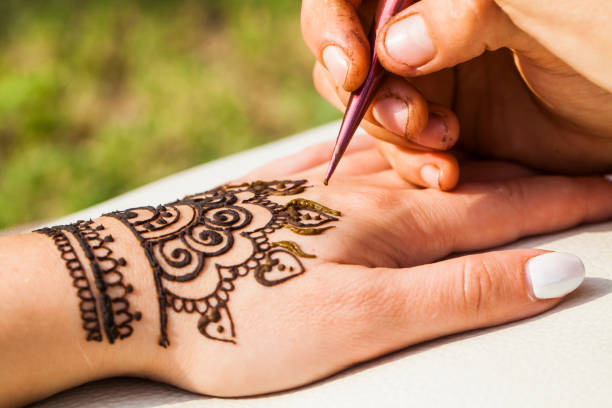What is Mehndi?
Mehndi is a form of body art and temporary skin decoration usually drawn on hands or legs, in which decorative designs are created on a person's body, using a paste, created from the powdered dry leaves of the henna plant (Lawsonia inermis). It is a popular form of body art among the women of India, Bangladesh, Pakistan, Nepal, Iran, Maldives, and the Muslim population of Sri Lanka, and resembles similar practices found in North Africa and the Middle East. This kind of body art is called Mehndi Design in India, Pakistan, Bangladesh, and Nepal. Whereas, in the west, it is called Henna Designs.
According to a 2013 study, henna has been used as a dye for the skin (as well as the hair and nails) for more than 4,000 years.
According to a Dictionary of Urdu, Classical Hindi and English Mehndi also refers to "the marriage-feast on the occasion of the bride's hand and feet being stained with henna" or "an ark, or tabernacle, carried in solemn procession by some Muslims on the eve of the anniversary of the death of a person who died just as he was about to marry - menhdi bandhna (-men)". It was originally used for only women's palms and sometimes for men, but as time progressed, it was more common for women to wear it.
There are many variations and designs. Women usually apply mehndi designs to their hands and feet, though some, including cancer patients and women with alopecia, occasionally decorate their scalps. The standard color of henna is brown, but other design colors such as white, red, black, and gold are sometimes employed.
Mehndi in Indian tradition is typically applied during Hindu Weddings and festivals like Karva Chauth, Vat Purnima, Diwali, Bhai Dooj, Navratri, Durga Pooja, and Teej. Muslims in South Asia also apply mehndi during Muslim weddings, festivals such as Eid-ul-Fitr and Eid-ul-Adha.
In Hindu festivals, many women have Henna applied to their hands and feet and sometimes on the back of their shoulders too, as men have it applied on their arms, legs, back, and chest. For women, it is usually drawn on the palm, back of the hand, and on feet, where the design will be clearest due to contrast with the lighter skin on these surfaces, which naturally contain less pigment melanin.
Alta, Alata, or Mahur is a red dye used similarly to henna to paint the feet of the brides in some regions of South Asia, for instance in Bangladesh and the Indian States of West Bengal.
Likely due to the desire for a "tattoo-black" appearance, some people add the synthetic dye p-Phenylenediamine (PPD) to henna to give it the black color. PPD may cause severe allergic reactions and be voted Allergen of the Year in 2006 by the American Contact Dermatitis Society.
Etymology
The origin of the word is from the Sanskrit word Mendhika.
Origins
The use of mehndi is first documented in Ancient Egypt as a decorative purpose for mummies. The use of mehndi as a decorative art was prevalent in fourth-century India, which is evident from cave art in the Deccan, specifically in the Ajanta Caves.
Tradition
Mehndi is a ceremonial art form common in India, Pakistan, Bangladesh, and Nepal. It is typically applied during weddings - for Sikh, Muslim, and Hindu brides. In Rajasthan, the grooms are given designs that are often as elaborate as those for brides. In Assam, apart from marriage, it is broadly used by unmarried women during Rongali Bihu.
Muslims in Afganistan also use it.
Process
Mehndi paste is usually applied to the skin using a plastic cone, a paintbrush, or a stick. After about 15-20 minutes, the mud will dry and begin to crack, and during this time, a mixture of lemon juice and white sugar can be applied over the henna design to remoisten the henna mud so that the henna will stain darker. The painted area is then wrapped with tissue, plastic, or medical tape to lock in body heat, creating a more intense color on the skin. The wrap (not a traditional method), is worn for two to six hours, or sometimes overnight, and then removed. When first removed, the henna design is pale to dark orange in color and gradually darkens through oxidation, over the course of 24 to 72 hours. The final color is reddish-brown and can last anywhere from one to three weeks depending on the quality and type of henna paste applied, as well as where it was applied on the body (thicker skin stains darker and longer than thin skin). Moisturizing with natural oils, such as olive, sesame seed, or coconut, will also help extend the lifetime of the stain. Skin exfoliation causes the henna tattoo to fade.
References;
1. Mehndi
by Wilson Levi
Tue, 03 Oct 23 08:58:04
by Wilson Levi
Tue, 03 Oct 23 08:47:41
by Wilson Levi
Tue, 03 Oct 23 08:44:45
Topics
Jammu & Kashmir - History, Culture & Traditions | J&K Current Trends | Social Network | Health | Lifestyle | Human Resources | Analytics | Cosmetics | Cosmetology | Forms | Jobs
Related blogs
How cosmetic industry in Belgium has changed over time? | Cosmetic Industry in Belgium
The cosmetic industry in Belgium has a rich...Benefits of Custard Apple extract for Skin, and Hair | Use of Custard Apple Extract in Cosmetics or...
Custard apple, also known as Annona cherimola, is...Benefits of Guava extract for Skin, and Hair | Use of Guava Extract in Cosmetics or Beauty Products
Guava, the tropical fruit celebrated for its...Benefits of Honey Extract for Skin and Hair | Use of Honey Extract in Cosmetic Products
Honey is not just a sweet treat for your taste...
Quote of the Day
"Time Flies Over, but Leaves its Shadows Behind"

